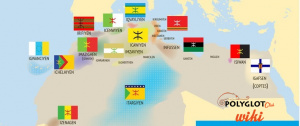Difference between revisions of "Language/Kabyle/Vocabulary/Colors"
< Language | Kabyle | Vocabulary
Jump to navigation
Jump to search
| Line 32: | Line 32: | ||
Tamawt/Remark/Remarque : | Tamawt/Remark/Remarque : | ||
Le féminin en kabyle se forme par l’ajout d’un « t » au début et à la fin du nom masculin | |||
The feminine noun in Kabyle is formed by adding "t" in the beggining and the end of masculine noun/Le féminin en kabyle se forme par l’ajout d’un « t » au début et à la fin du nom masculin. | |||
Revision as of 13:20, 25 April 2020
Colors
Initen
Vocabulary
Amawal
Initen (Ini = color/couleur)/The colors/Les couleurs :
- Amellal = White/Blanc (Tamellalt = white/blanche) plural/pluriel : (Imellalen = white/blancs , Timellalin = whites/blanches)
- Aberkan = Black/Noir (Taberkant = black/noire) plural/pluriel : (Iberkanen = black/noirs , Tiberkanin = black/noires)
- Awraγ = Yellow/Jaune (Tawraγt = Yellow/Jaune) plural/pluriel : (Iwraγen = yellow/jaunes, yellow/Tiwraγin = jaunes)
- Adal = Green/Vert (Tadalt = green/verte) plural/pluriel : (Idalen = green/verts, Tidalin = green/vertes)
- Azegzaw = Blue/Bleu (Tazegzawt = blue/bleu) plural/pluriel : (Izegzawen = blue/bleus, Tizegzawin = blue/bleues)
- Azeggaγ = Red/Rouge (Tazeggaγt = red/rouge) plural/pluriel : (Izeggaγen = red/rouges, Tizeggaγin = red/rouges)
- Arzaz = Purple/Violet (Tarzazt = purple/violette) plural/pluriel : (Irzazen = purple/violets, Tirzazin = purple/violettes)
- Aranği = Orange/Orange (Taranğit = orange/orange) plural/pluriel : (Iranğiyen = orange/oranges, Tiranğiyin = orange/oranges)
- Axuxi = Pink/Rose (prononcé : Akhukhi) (Taxuxit = pink/rose) plural/pluriel : (Ixuxiyen = pink/roses, Tixuxiyin = pink/roses)
- Aras = Brown/Marron ( Tarast = brown/brune = marronne) plural/pluriel : (Irasen = brown/marrons, Tirasin = brown/brunes = marronnes) (Aksum aras = brown skin/peau brune ; Aksum = skin/chair = peau, Aras = Brown/Marron couleur brune).
Tamawt/Remark/Remarque :
The feminine noun in Kabyle is formed by adding "t" in the beggining and the end of masculine noun/Le féminin en kabyle se forme par l’ajout d’un « t » au début et à la fin du nom masculin.
Asisleγ/Practice/Application :
Amedya/Example/Exemple :
Singular/Singulier (masculine/masculin, feminine/féminin)
- Γur-i amcic d amellal = I have a white cat/j’ai un chat blanc (Γur-i = I have/j’ai, amcic = cat/chat (amchich), d = is/est, amellal = white/blanc), on peut dire : j’ai un chat qui est blanc (d’où « d = est »/we can say i have a cat that is white (where "d = is").
- Wallaγ titbirt d tamellalt = I saw a white dove/j’ai vu une colombe blanche (wallaγ = I saw/j’ai vu, titbirt = dove/colombe (prononcé : thithvirth), d = is/est, tamellalt = white/blanche).
Plural/Pluriel (masculine/masculin, feminine/féminin)
- Ifrax imellalen = White birds/les oiseaux blancs (Afrux (Afrukh) = bird/oiseau)
- Titbirin timellalin = white doves/colombes blanches.
Amawal/Vocabulary/Vocabulaire :
- Amalay/Awtem (Awthem) = Masculine/Masculin
- Asgwet (prononcé : Asgweth) = Plural/Pluriel
- Asisleγ = Practice/Application
- Asuf = Singular/Singulier
- Itbir (Ithvir) = Pigeon/Pigeon
- Unti (prononcé : Ounthi) = Tawtemt (Thawthemt) = Feminine/Féminin
- Titbirt (Tithvirth) = Dove/Colombe
